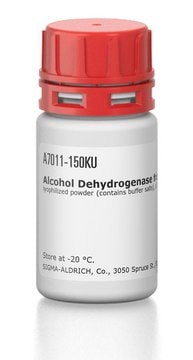10109339001
Roche
Sorbitol Dehydrogenase (SDH)
from sheep liver
Synonyme(s) :
SDH, Sorbitol Dehydrogenase, sorbitol
About This Item
Produits recommandés
Source biologique
sheep liver
Forme
lyophilized
Activité spécifique
~40 units/mg protein (At 25 °C with D-fructose as the substrate.)
Poids mol.
115 kDa
Conditionnement
pkg of 10 mg (60 mg lyophilizate)
Fabricant/nom de marque
Roche
Concentration
0.16 mg/mL Biuret
Technique(s)
activity assay: suitable
Couleur
white
pH optimal
7.5
Solubilité
water: 60 mg/mL, clear, colorless
Adéquation
suitable for ELISA applications
Numéro d'accès NCBI
Numéro d'accès UniProt
Application(s)
life science and biopharma
Activité étrangère
ADH <0.00182%
GIDH <0.00152%
Glucose-DH <0.00182% (NAD as coenz.)
LDH <0.00167%
MDH <0.00198%
NADH oxidase 0.00532%
Température de stockage
2-8°C
Informations sur le gène
sheep ... SORD(101115280)
Description générale
Sorbitol dehydrogenase (SDH) from sheep liver has a molar mass of 152kDa. The protein is a tetramer of four identical subunits. Each of these subunits has 355 amino acid residues, of which 10 are cysteine residues. Each subunit contains a zinc atom at the active site, which is associated with three protein ligands and a water molecule. The zinc atom associates with the oxygen of the sorbitol hydroxyl or of the fructose carbonyl interconverted during catalysis.
Application
Actions biochimiques/physiologiques
Qualité
Définition de l'unité
Forme physique
Notes préparatoires
Stabilizers: Maltose is used as stabilizer.
Storage conditions (working solution): An aqueous solution is stable at 2 to 8 °C for several weeks.
Stockage et stabilité
Autres remarques
Code de la classe de stockage
11 - Combustible Solids
Classe de danger pour l'eau (WGK)
WGK 1
Point d'éclair (°F)
does not flash
Point d'éclair (°C)
does not flash
Faites votre choix parmi les versions les plus récentes :
Déjà en possession de ce produit ?
Retrouvez la documentation relative aux produits que vous avez récemment achetés dans la Bibliothèque de documents.
Les clients ont également consulté
Notre équipe de scientifiques dispose d'une expérience dans tous les secteurs de la recherche, notamment en sciences de la vie, science des matériaux, synthèse chimique, chromatographie, analyse et dans de nombreux autres domaines..
Contacter notre Service technique









